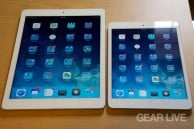Sunday November 6, 2016 6:44 pm
Bleeding Edge TV 598: Xbox One S vs. Xbox One Comparison

Posted by Andru Edwards Categories: Features, Home Entertainment, Microsoft, PC / Laptop, Podcasts, Video Games, Videocasts, Videos,
Microsoft has launched the Xbox One S, a newly updated version of the classic Xbox One that it released back in November of 2013. In this episode, I highlight all of the key differences between the first Xbox One and the new Xbox One Slim, giving you a look at what's changed and if those changes are worth your attention. I'll cover:
- The Hardware Changes
- 4K Blu-ray Support
- 4K Video Streaming
- 4K Game Upscaling
- HDR Support
Are you picking up an Xbox One S? Or are you waiting for Project Scorpio?
You can pick up the Xbox One S now.
Don't forget to subscribe to Gear Live's YouTube channel--also, we are giving away awesome perks for our Patreon backers - thanks for your support!
[Download] - iPod-formatted H.264
[Download] - High Definition H.264
[Download] - MPEG-4
[Download] - MP3
| Subscribe to Bleeding Edge TV… | iTunes | Others |
|---|---|---|
| Standard version |
 |
 |
| 720p HDTV M4V version |  |
 |
| 1080p HDTV MP4 version |  |
 |
Video Transcript:
In my last video, I brought you my review of the Xbox One S, the newly released slimmed down flagship game console from Microsoft that packs in a bunch of 4K features. I got a lot of people asking about the main differences between the new Xbox One S and the original Xbox One, so I figured I’d do a follow-up video to address exactly that. So, let’s kick it off starting with the most obvious difference - the way it looks.
HARDWARE
Show someone the original Xbox One, and then the Xbox One S, and if they aren’t a gamer, they’d likely not be able to tell that these are essentially the same console platform. When the Xbox One was released a few years ago, it was huge and clunky, and sported a larger power brick to boot. Compare that to the Xbox One S, and it’s a night and day difference.
Gone is the bulky external power brick, replaced by a simple power cord. Not only was Microsoft able to reduce the size of the Xbox One S by 40%, they were also able to move the power supply into the Xbox One S console itself at the same time! Looking on back, all the ports are the same, with the exception of the omission of the Kinect port on the new model. It appears that Microsoft is phasing out the Kinect, and instead wants gamers to use a headset microphone for voice commands, and the new built-in IR blaster on the front of the Xbox One S for remote control of other home theater devices.
Another key hardware difference is that the Xbox One S can stand vertically with the optional vertical stand accessory. If you buy the 2TB model, you’ll get the stand included in the box. If not, it’ll cost you $19.99.
The included controller for the Xbox One S has some minor changes as well, the biggest of which is that it now supports Bluetooth connectivity to the console, as well as PCs and even mobile devices like smartphones and tablets. It also has a more tactile finish on the hand grips, making it less slippery, and the thumbsticks have been improved as well.
4K BLU-RAY
Next up, 4K Blu-ray. This is actually a big deal. The original Xbox One played standard Blu-rays and DVDs, while the new Xbox One S adds in support for 4K Blu-ray. Since the Xbox One S starts at $299, it’s officially the cheapest 4K Blu-ray player that you can buy - and it does way more than just play 4K Blu-ray discs, unlike the standalone units. This means that people who own a 4K television and want to play 4K discs will likely be seriously considering the Xbox One S, even if they aren’t necessarily gamers. That could be a huge win for Microsoft. The one caveat I’ve found so far is that if you have a high-end speaker system and receiver in your home that supports Dolby Atmos or DTS:X like I do, the Xbox One S doesn’t send that untouched audio directly from the disc over to your receiver. In fact, for whatever reason, I’ve found that it struggled to even send uncompressed 7.1 audio. Microsoft has said that an update is forthcoming for the high definition audio options though, and if you don’t have a crazy sound system in the first place, then this won’t affect you at all.
4K VIDEO STREAMING
The next feature that sets the Xbox One S apart from the original is 4K Video Streaming. Services like Netflix, Amazon Prime Video, and YouTube support streaming 4K video, which the original Xbox One didn’t support. With the new version, you get access to the higher resolution videos that these services have to offer. That means you can pull up my YouTube channel on your Xbox One S, and watch this video in glorious 4K.
4K GAME UPSCALING
Another new feature found on the Xbox One S is 4K game upscaling. You’re probably sensing a pattern here - Microsoft spent a lot of time optimizing the Xbox One S for the new influx of 4K televisions. To be clear though, this is 4k *upscaling* - not true 4K gaming. You’ll have to wait for next years much more powerful Xbox One release, Project Scorpio for true 4k gaming and virtual reality. Instead, the Xbox One S takes whatever the resolution is from the game you’re playing, and upscales it to 4K before sending the signal to your television. That’ll make the games look better if you’re playing them on a 4K set, but it won’t be using 4K textures.
HDR
Finally, the big change that I love the most, HDR capability. When most people think of HDR< they think of photography. With video, HDR means that the dynamic range between the darkest colors and the brightest colors that your television can display is much wider. It really is something you have to see for yourself, but the colors are amazing and more true to life, and the brightness is unlike anything you’ve seen on a television. The Xbox One S supports HDR for streaming, for 4K Blu-ray discs, and for gaming. You’ll need a television capable of displaying the open HDR10 spec, as opposed to a TV that can only display Dolby Vision HDR to take advantage of it, and in my tests, HDR on both 4K Blu-ray and streaming from Netflix looked great. I couldn’t test high dynamic range gaming though, because Microsoft won’t be releasing any HDR-capable games until the fall. You’d think they would have launched SOMETHING alongside the new console to show it off…but, nope.
So there you have it guys, the 5 big changes Microsoft introduced to the Xbox One S that make it even better than the original Xbox One. Now I want to hear from you - is it enough to make you want to upgrade? Are you gonna wait for Project Scorpio instead? Sound off in the comments below, and I’ll meet you there for further discussion. Be sure to hit the like button if you enjoyed this one, and when you see my face appear in the video, click on it and hit subscribe if you aren’t already to stay up to date on my future videos, including the upcoming Xbox One S giveaway. Thanks a lot for watching as always, I appreciate the support - this is Andru Edwards, and I’ll catch you in the next video.
You can also find us on:
- Twitter: Gear Live - Andru Edwards
- Facebook: Gear Live - Andru Edwards
- Google+: Gear Live - Andru Edwards
- Instagram: Gear Live - Andru Edwards
- Pinterest: http://pinterest.com/andru
- Tumblr: http://andru.tumblr.com
- Related Tags:
- 4k blu-ray, 4k blu-ray player, andru, andru edwards, gear live, microsoft, microsoft xbox one s, project scorpio, review, unboxing, white xbox one, xbox, xbox 360, xbox one, xbox one s, xbox one s 2tb, xbox one s 4k, xbox one s comparison, xbox one s controller, xbox one s features, xbox one s gears of war 4, xbox one s hdr, xbox one s review, xbox one s specs, xbox one s unboxing, xbox one s vs ps4, xbox one s vs xbox one, xbox one s vs xbox one comparison, xbox one slim
Advertisement
Comments:
Advertisement
Advertisement
© Gear Live Media, LLC. 2007 – User-posted content, unless source is quoted, is licensed under a Creative Commons Public Domain License. Gear Live graphics, logos, designs, page headers, button icons, videos, articles, blogs, forums, scripts and other service names are the trademarks of Gear Live Inc.











Forum Discussion
Come join the discussion on this topic over on the Gear Live message boards. You need to be a member to participate, so sign up if you haven't already - it's free!